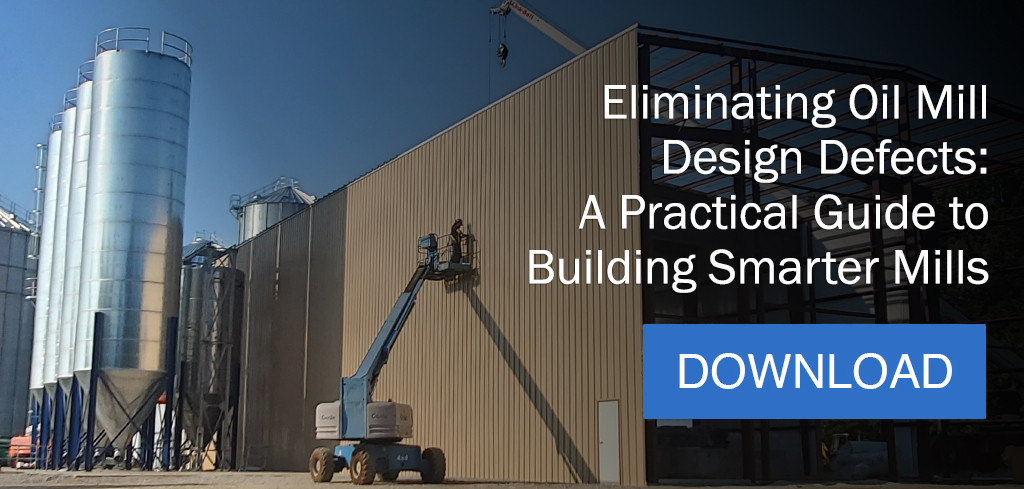
Oil mills represent a major investment, and every design choice has lasting consequences. A single oil mill design defect can reduce efficiency, drive up maintenance costs, and limit future growth.
From undersized conveyors to poor ventilation, the mistakes often seem small at first but become costly bottlenecks as production scales.
By identifying common pitfalls, mill operators and investors can ensure their facilities deliver long-term returns instead of recurring frustrations.
Planning for expansion is not optional
One of the most common oil mill design defects is building a facility that meets only today’s production targets. A plant designed for 100 tons per day is not simply half the cost of one designed for 200 tons.
In many cases, the upfront investment to build larger—or at least leave space for expansion—pays off significantly in the long run. Even something as simple as oversizing conveyors, dryers, or cooling systems at the start can save operators from costly retrofits. Running extruders and expellers at rated capacity is essential, but supporting systems can often be upsized affordably to leave room for growth.
Also read: Minimizing Oil Mill Operator Error in Your Soybean Processing Plant
Conveyors: The hidden bottleneck
Conveyors are the backbone of any oil mill, yet they are often undersized. Choosing a smaller, “custom” size might look like a cost-saving decision, but it can be more expensive and create unnecessary limitations.
Standard, larger sizes not only move more material but also cost less in many cases. Without properly sized conveyors, a mill faces constant throughput challenges. This oil mill design defect is especially damaging because conveyors connect every stage of the operation—any restriction ripples through the entire system.
Recycle and escape points
Even the best systems encounter blockages. Without planned recycling points, material can pile up and disrupt production. Operators create flexibility for handling start-up issues or emergency purges by adding dump-back points or bypasses. The absence of these options is a classic oil mill design defect, leaving workers with no choice but to shut down entirely during even minor disruptions.
Material durability and ventilation issues
Hot material transport is another overlooked design element.
Using carbon steel conveyors for products above 212°F results in rapid corrosion, forcing operators to replace entire systems within a few years. Stainless steel may cost more upfront, but it prevents premature failures. Likewise, ventilation around presses and extruders must strike a balance: removing excess moisture without stripping out needed heat. Poorly designed exhaust systems can create mold risks or reduce press performance, which are preventable with smart planning.
Also read: Four Keys to Proper Soybean Storage
Accessibility and maintenance space
Maintenance should be built into the design, not treated as an afterthought. Tight clearances, missing overhead doors, or a lack of crane access make replacing heavy components time-consuming and hazardous. Overlooking space for safe forklift operation or part removal is another oil mill design defect that adds unnecessary downtime.
In contrast, plants that allow technicians to easily access, lift, and replace components recover from breakdowns faster and maintain higher uptime.
Other costly oversights to avoid
In addition to the major problem areas, operators should watch for smaller but equally damaging design flaws, including:
- Failing to install in-house analysis tools, leaving production quality dependent on slow external lab results.
- Not planning for water addition to compensate for moisture loss during processing.
- Ignoring oil storage tank design, which can cause sediment buildup and costly cleanouts if agitation or access points are missing.
- Overlooking spare parts storage, which extends downtime during breakdowns.
- Skipping automation in control systems, which limits efficiency and prevents future use of AI-driven technology.
Also read: Fire Up Your Plant with Oilseed Processing Equipment Commissioning from Anderson
The cost of ignoring defects
Every oil mill design defect carries a cost—lost efficiency, higher maintenance, or wasted resources. Many of these issues only become clear years after construction, when correcting them requires major retrofits. By working with experienced partners who understand both equipment and plant flow, operators can avoid the most common mistakes.
For more information about designing oil mills that maximize efficiency and profitability, contact Anderson International today.
